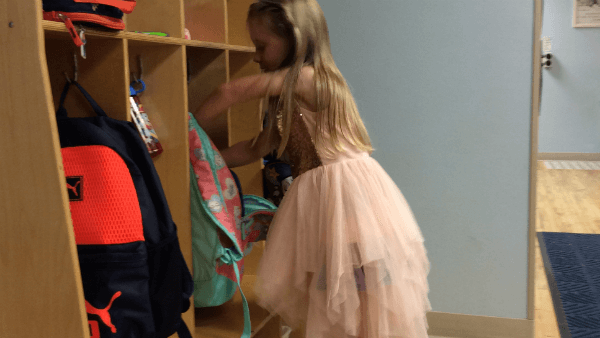What a great first week! For many of our students and families, coming back to school was a welcome return to consistency. Sometimes, when we are returning families, we take for granted how happy and excited our children are to return to the familiar activities and friends that they are used to seeing. We have completely forgotten that one day, not that long ago (or for some of us, quite some time ago!) our own child or children had a tough time letting go of our hand, and watching us walk out the door. Those were tough days on everyone! Intellectually, we knew that our child was safe, well cared for, and would be fine in a short amount of time, but if we were honest with ourselves, thoughts full of doubt and guilt racked our minds all day, imagining strange scenarios of neglected crying children sitting in the corner, with a witch-like teacher yelling at them to be quiet. I mean, honestly, no one else but ourselves could possibly comfort our child, right? After a few days, or weeks, we all got into a routine, and drop off time was much easier. And now look at us… kiddos can’t wait to get into the classroom and leave us parents behind!
For some families, especially for new families, drop off is much like I described above—the not-so-pretty scenario. So, to help speed up the normalization of drop off for our newest friends, I have compiled a list of helpful tips that we can implement to help alleviate the self-doubt and emotional turmoil of morning drop offs not only for our young friends, but for our parent friends as well. (Returning parents: Feel free to engage an unfamiliar face in conversation, goodness knows it would be a welcome distraction, and a great opportunity to meet a fellow LMSS parent!)
1) Get a good night’s sleep, then a good breakfast: Hungry and tired kids (and adults) are more likely to be clingy and cranky, which is a perfect combo for a drop off meltdown. By getting a good night’s sleep with a full belly, kids are primed for a good morning. Each child is different, and you will know yours best. If they need extra time to wake up and face the day, help yourself by moving wake-up time (and bedtime) even earlier.
2) Stay positive! Even though you may have had a few days of tough drop-offs, don’t lose faith, and don’t lose faith in your child. They can hear things you may not even say. Your body language and tone of voice says a lot to them. So, even if you speak positively, if you do so with a resigned, waiting for the shoe to drop kind of tone, they will not feel like they are going to a safe place. Focus on positive aspects throughout the day. Ask about what types of activities they may choose to work on, or which friend they may want to ask to play at recess. Don’t get bogged down by reminding them that other children don’t cry, or that they have no reason to cry, etc.
3) This might be the hardest part: Project confidence about drop off, the school, the teachers, and your child’s friends. Be cheerful and concise. Your child will know if you are hesitant about leaving them. You may be concerned for their emotional well being, but they take it as a concern for their basic well being, which results in the child not wanting to let you out of their sight.
4) Keep the goodbyes short and sweet. Lingering over goodbyes, especially when the child is upset and crying gives the child mixed signals. By remaining in line of sight, or not letting him/her go, they are receiving a signal that they are in an unpleasant situation that you don’t trust. When you do leave, it will take that much longer for the child to settle and feel confident in their surroundings. Be positive, reassure the child that they will be fine, have a great day, give a kiss and hug, say goodbye, then walk out the door. Do not turn and look back at your child. It is absolutely OK to call or email us at school to ask how your child is adjusting. We will often go in and take a picture of your child to show how they are settling in. If the child remains upset, we will call you to discuss ways we can work together to help with the adjustment of school.
5) Be consistent: Coming in with a good plan to have a good drop off system is really helpful. Unfortunately, plans don’t always work the way we want. That said, it is crucial for us adults to remain consistent with our goodbye process (tradition). Young children especially rely on the consistent to feel safe and secure. When they know that they will get one hug, a kiss, then a fist bump before heading off to class, they have an easier time focusing on class, instead of where mom or dad might be. Conversely, if I as a parent gave a hug and kiss, then walked into the classroom to give “one more,” the child would no longer really know what is expected of him. He will be more focused on watching the door to see if I come back for another hug and kiss rather than the awesome works in the classroom.
6) In addition to these tips above, you can also give your child a special item, such as a bracelet, or hair clip that belongs to mom, to keep mom close. Or a hat from dad to be kept in their cubby. A lovey from home could also be brought, but it would be encouraged to keep it in their cubby.
I promise you, this phase too shall pass. It is difficult and a special kind of heartbreaking to walk away from our children who are crying for us, but it truly is in their best interest to be strong and confident during drop offs. Feel free to reach out to us with any questions or concerns you may have. We are always willing to help, because really, it takes a village!


